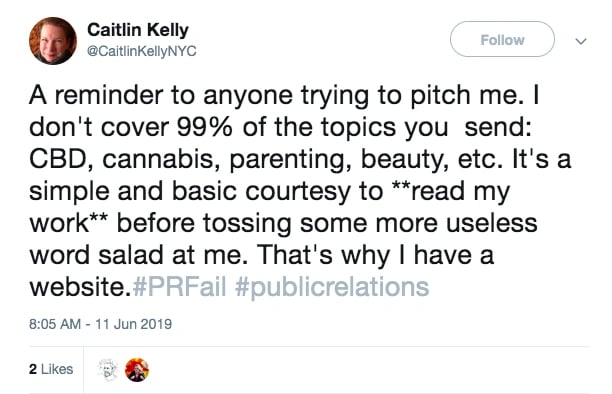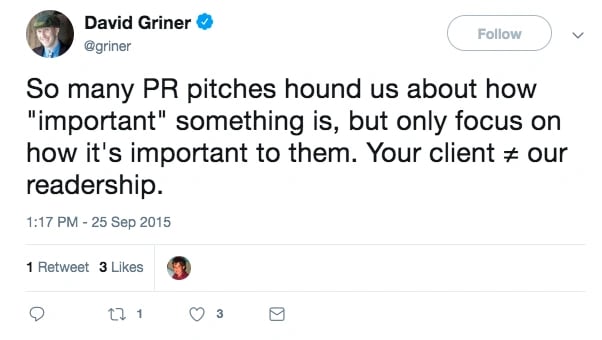Spend any amount of time searching the hashtag #PRFail on Twitter and you won't struggle to find journalists lamenting about all of the bad PR pitches they received this week.

The relationship between journalists and PR professionals is complicated. While PR professionals need the media in order for their job to function, it's also true that to some degree, journalists rely on PR professionals to deliver newsworthy story ideas directly to their inboxes.
Even though there are some #PRFail horror stories with shockingly bad tactics, these instances are still the minority.
PR pros usually teeter on a fine line between professionally offering content of value to a journalist -- and rubbing them the wrong way.
Since PR professionals rely so heavily on their relationships with media contacts, it's important to be professional in communication efforts and not bite the hand that feeds you, so to speak.
My team at Fractl has been earning top-tier coverage in the media for our clients for over six years, and we have always been interested in learning how to establish real, trusting relationships with media contacts to better serve our clients.
In an attempt to uncover what methods of communication really irks journalists, we surveyed 500+ journalists, editors, and freelance contributors to learn the most offensive email pitch pet peeves in 2019.
Let's dive into those, now.
Journalists' Top Ten Email Pitch Pet Peeves

1. Receiving an irrelevant pitch.
The most offensive PR practice as reported by over 500 journalists -- by far -- is receiving a pitch that is irrelevant to the writers' beat.
A message to all PR practitioners: stop doing this.
Receiving an irrelevant pitch is easily the number one complaint from journalists. If a writer covers sustainable beauty, don't pitch them about your sustainable fashion clients. There's a better writer you could target.
Alternatively, if a writer covers personal finance, don't pitch them your bitcoin related content unless their author archives suggest it's highly relevant to something they've expressed interest in before.
Do your research, and then do it again. You might be certain that content you're offering is relevant to a certain publication, but check to make sure. For example, Bustle.com covers all sorts of women's interest topics. At first glance, you might think it's a good fit to pitch a piece of content detailing female millennials favorite trendy diets. But you'd be wrong. This publisher is adamant about not covering anything related to diets or body shaming.
Research pays off.

2. Receiving too many follow-ups.
How many follow-ups becomes too many follow-ups? When is it okay to send a follow-up email? What should you include in a follow-up email? We asked journalists these questions and we found that online writers, editors, and freelance contributors prefer zero or one follow-up emails -- and want to receive it an average of three to seven days after you've sent your initial pitch.


Image Source
3. Receiving a pitch that is too self promotional without a real story.
Lastly, one bad PR practice to avoid is pitching a journalist a "story" when in reality you're just hoping they'll cover your client without offering anything to them that could be considered newsworthy.
For the most part, journalists aren't interested in quoting someone in your organization without any context -- nor do they want to write about new products or company updates.

It's important to make sure you're offering something of value to writers and editors.
Create compelling, newsworthy content that would appeal to their readership, and tie it back to your client's goal or mission. Then, once you have a relevant pitch, reach out.
One popular content marketing format is using data to tell a story. Delve into an existing data set, run a survey (like we did in this article), or analyze trends in order to speak out about a common issue within your niche. Bring something truly interesting to the table and journalists will be that much more likely to cover your content (and your client).
Advice from Top Tier Journalists
We asked hundreds of journalists from top online publishers like TIME, CNN, The New York Times, Bustle and more the following question: “If you could give 1-3 points of feedback to the people pitching you, what would you say?”
Read their industry advice and feedback in the flipbook, below.
The Top Ten Worst PR Tactics
To summarize our findings in their entirety, these are the top ten worst pet peeves regarding PR pitches with which journalists struggle:
- Hasn’t researched your work / Irrelevant to your beat
- Hasn’t researched the publication you write for
- Too many follow-ups
- Self-promotional without a real story
- Cold calling
- Mass email blasts
- Generic angle to a common story
- Lack of cooperation or transparency (i.e. broken embargoes)
- Not personalized
- Copy of a press release
Remember -- even if you avoid the ten bad practices above, it's still not guaranteed that your pitch will be well-received.
The first step to earning press mentions for your client is to create a survey, study, or interactive so compelling, newsworthy, or surprising that a writer can't resist covering it.
The second step is to build an outreach list full of online writers and editors that often cover the niche your content falls into to ensure the content is relevant to their audience.
The third step is to neatly and succinctly pack the most interesting data into an email pitch that communicates the gist of your content without being too self-promotional or generic.
Follow these steps, and you'll be well on your way to building positive, mutually beneficial relationships with the media.


![How to Write a Press Release [Free Press Release Template + 2024 Examples]](https://blog.hubspot.com/hubfs/press-release-template_9.webp)






![How to Write an Effective Communications Plan [+ Template]](https://blog.hubspot.com/hubfs/communication-lan_6.webp)
![Should You Pay a PR Firm? [+PR Tactics You Can Manage In-House]](https://blog.hubspot.com/hubfs/hire-pr-fi%20%281%29.jpg)
